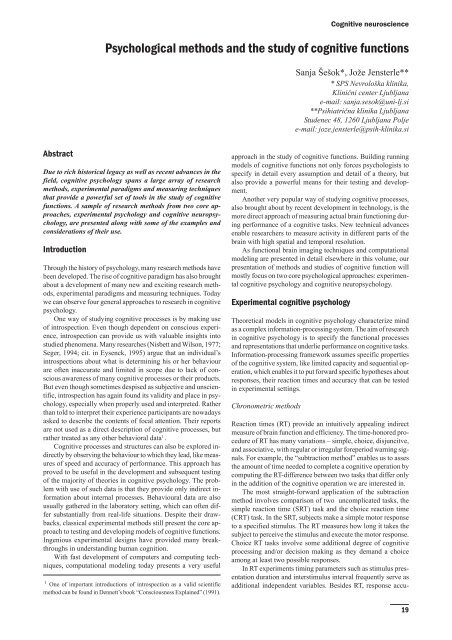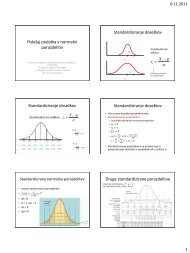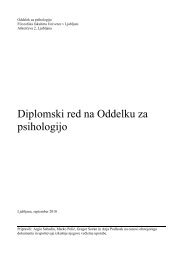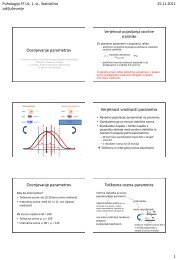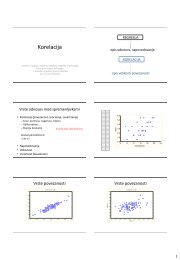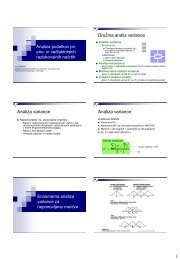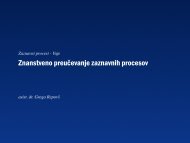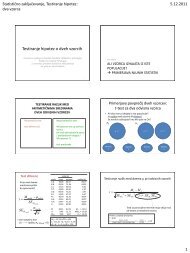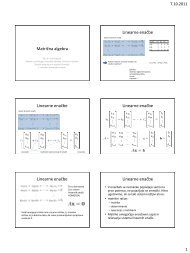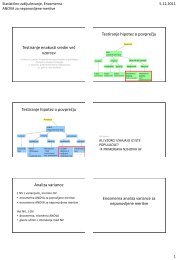Psychological methods and the study of cognitive functions
Psychological methods and the study of cognitive functions
Psychological methods and the study of cognitive functions
Create successful ePaper yourself
Turn your PDF publications into a flip-book with our unique Google optimized e-Paper software.
Cognitive neuroscience<strong>Psychological</strong> <strong>methods</strong> <strong>and</strong> <strong>the</strong> <strong>study</strong> <strong>of</strong> <strong>cognitive</strong> <strong>functions</strong>Sanja Šešok*, Jože Jensterle*** SPS Nevrološka klinika,Klinični center Ljubljanae-mail: sanja.sesok@uni-lj.si**Psihiatrična klinika LjubljanaStudenec 48, 1260 Ljubljana Poljee-mail: joze.jensterle@psih-klinika.siAbstractDue to rich historical legacy as well as recent advances in <strong>the</strong>field, <strong>cognitive</strong> psychology spans a large array <strong>of</strong> research<strong>methods</strong>, experimental paradigms <strong>and</strong> measuring techniquesthat provide a powerful set <strong>of</strong> tools in <strong>the</strong> <strong>study</strong> <strong>of</strong> <strong>cognitive</strong><strong>functions</strong>. A sample <strong>of</strong> research <strong>methods</strong> from two core approaches,experimental psychology <strong>and</strong> <strong>cognitive</strong> neuropsychology,are presented along with some <strong>of</strong> <strong>the</strong> examples <strong>and</strong>considerations <strong>of</strong> <strong>the</strong>ir use.IntroductionThrough <strong>the</strong> history <strong>of</strong> psychology, many research <strong>methods</strong> havebeen developed. The rise <strong>of</strong> <strong>cognitive</strong> paradigm has also broughtabout a development <strong>of</strong> many new <strong>and</strong> exciting research <strong>methods</strong>,experimental paradigms <strong>and</strong> measuring techniques. Todaywe can observe four general approaches to research in <strong>cognitive</strong>psychology.One way <strong>of</strong> <strong>study</strong>ing <strong>cognitive</strong> processes is by making use<strong>of</strong> introspection. Even though dependent on conscious experience,introspection can provide us with valuable insights intostudied phenomena. Many researches (Nisbett <strong>and</strong> Wilson, 1977;Seger, 1994; cit. in Eysenck, 1995) argue that an individual’sintrospections about what is determining his or her behaviourare <strong>of</strong>ten inaccurate <strong>and</strong> limited in scope due to lack <strong>of</strong> consciousawareness <strong>of</strong> many <strong>cognitive</strong> processes or <strong>the</strong>ir products.But even though sometimes despised as subjective <strong>and</strong> unscientific,introspection has again found its validity <strong>and</strong> place in psychology,especially when properly used <strong>and</strong> interpreted. Ra<strong>the</strong>rthan told to interpret <strong>the</strong>ir experience participants are nowadaysasked to describe <strong>the</strong> contents <strong>of</strong> focal attention. Their reportsare not used as a direct description <strong>of</strong> <strong>cognitive</strong> processes, butra<strong>the</strong>r treated as any o<strong>the</strong>r behavioral data 1 .Cognitive processes <strong>and</strong> structures can also be explored indirectlyby observing <strong>the</strong> behaviour to which <strong>the</strong>y lead, like measures<strong>of</strong> speed <strong>and</strong> accuracy <strong>of</strong> performance. This approach hasproved to be useful in <strong>the</strong> development <strong>and</strong> subsequent testing<strong>of</strong> <strong>the</strong> majority <strong>of</strong> <strong>the</strong>ories in <strong>cognitive</strong> psychology. The problemwith use <strong>of</strong> such data is that <strong>the</strong>y provide only indirect informationabout internal processes. Behavioural data are alsousually ga<strong>the</strong>red in <strong>the</strong> laboratory setting, which can <strong>of</strong>ten differsubstantially from real-life situations. Despite <strong>the</strong>ir drawbacks,classical experimental <strong>methods</strong> still present <strong>the</strong> core approachto testing <strong>and</strong> developing models <strong>of</strong> <strong>cognitive</strong> <strong>functions</strong>.Ingenious experimental designs have provided many breakthroughsin underst<strong>and</strong>ing human cognition.With fast development <strong>of</strong> computers <strong>and</strong> computing techniques,computational modeling today presents a very useful1One <strong>of</strong> important introductions <strong>of</strong> introspection as a valid scientificmethod can be found in Dennett’s book “Consciousness Explained” (1991).approach in <strong>the</strong> <strong>study</strong> <strong>of</strong> <strong>cognitive</strong> <strong>functions</strong>. Building runningmodels <strong>of</strong> <strong>cognitive</strong> <strong>functions</strong> not only forces psychologists tospecify in detail every assumption <strong>and</strong> detail <strong>of</strong> a <strong>the</strong>ory, butalso provide a powerful means for <strong>the</strong>ir testing <strong>and</strong> development.Ano<strong>the</strong>r very popular way <strong>of</strong> <strong>study</strong>ing <strong>cognitive</strong> processes,also brought about by recent development in technology, is <strong>the</strong>more direct approach <strong>of</strong> measuring actual brain functioning duringperformance <strong>of</strong> a <strong>cognitive</strong> tasks. New technical advancesenable researchers to measure activity in different parts <strong>of</strong> <strong>the</strong>brain with high spatial <strong>and</strong> temporal resolution.As functional brain imaging techniques <strong>and</strong> computationalmodeling are presented in detail elsewhere in this volume, ourpresentation <strong>of</strong> <strong>methods</strong> <strong>and</strong> studies <strong>of</strong> <strong>cognitive</strong> function willmostly focus on two core psychological approaches: experimental<strong>cognitive</strong> psychology <strong>and</strong> <strong>cognitive</strong> neuropsychology.Experimental <strong>cognitive</strong> psychologyTheoretical models in <strong>cognitive</strong> psychology characterize mindas a complex information-processing system. The aim <strong>of</strong> researchin <strong>cognitive</strong> psychology is to specify <strong>the</strong> functional processes<strong>and</strong> representations that underlie performance on <strong>cognitive</strong> tasks.Information-processing framework assumes specific properties<strong>of</strong> <strong>the</strong> <strong>cognitive</strong> system, like limited capacity <strong>and</strong> sequential operation,which enables it to put forward specific hypo<strong>the</strong>ses aboutresponses, <strong>the</strong>ir reaction times <strong>and</strong> accuracy that can be testedin experimental settings.Chronometric <strong>methods</strong>Reaction times (RT) provide an intuitively appealing indirectmeasure <strong>of</strong> brain function <strong>and</strong> efficiency. The time-honored procedure<strong>of</strong> RT has many variations – simple, choice, disjuncitve,<strong>and</strong> associative, with regular or irregular foreperiod warning signals.For example, <strong>the</strong> “subtraction method” enables us to asses<strong>the</strong> amount <strong>of</strong> time needed to complete a <strong>cognitive</strong> operation bycomputing <strong>the</strong> RT-difference between two tasks that differ onlyin <strong>the</strong> addition <strong>of</strong> <strong>the</strong> <strong>cognitive</strong> operation we are interested in.The most straight-forward application <strong>of</strong> <strong>the</strong> subtractionmethod involves comparison <strong>of</strong> two uncomplicated tasks, <strong>the</strong>simple reaction time (SRT) task <strong>and</strong> <strong>the</strong> choice reaction time(CRT) task. In <strong>the</strong> SRT, subjects make a simple motor responseto a specified stimulus. The RT measures how long it takes <strong>the</strong>subject to perceive <strong>the</strong> stimulus <strong>and</strong> execute <strong>the</strong> motor response.Choice RT tasks involve some additional degree <strong>of</strong> <strong>cognitive</strong>processing <strong>and</strong>/or decision making as <strong>the</strong>y dem<strong>and</strong> a choiceamong at least two possible responses.In RT experiments timing parameters such as stimulus presentationduration <strong>and</strong> interstimulus interval frequently serve asadditional independent variables. Besides RT, response accu-19
Information society 2001racy can also be used as a dependent variable in a range <strong>of</strong> differentstimulus presentation paradigms with a number <strong>of</strong> taskperformance criteria. Combined with RT, it provides a measure<strong>of</strong> accuracy-speed trade<strong>of</strong>fs, such as <strong>the</strong> changes in accuracywhen time to perform is changed. Finally, verbal reports by subjects<strong>of</strong> <strong>the</strong>ir own conscious processes during task performancehave also been used as dependent measures in RT experiments.Sternberg’s paradigmThe basic paradigm for <strong>study</strong>ing speed <strong>of</strong> retrieval from shorttermmemory was introduced into psychology by Sternberg(Eysenck, 1969). Sternberg built on <strong>the</strong> assumption that reactiontime from stimulus to response is really a composite or asum <strong>of</strong> reaction times <strong>of</strong> a series <strong>of</strong> sequential subprocesses thatone has to carry out in order to complete <strong>the</strong> task. He suggestedthat in order to <strong>study</strong> a specific component, one has to set up anexperimental task in which all o<strong>the</strong>r components are kept constant<strong>and</strong> only <strong>the</strong> component that we are interested in is systematicallyvaried. In his experiment, two to six items, generallyreferred to as <strong>the</strong> “memory set”, were presented to <strong>the</strong> subjectin short succession. A probe item was <strong>the</strong>n presented shortlyafter <strong>the</strong> memory set. The subject’s task was to decide as rapidlyas possible whe<strong>the</strong>r or not <strong>the</strong> probe matched one <strong>of</strong> <strong>the</strong> items in<strong>the</strong> memory set. The results showed that <strong>the</strong> reaction times increaselineary with number <strong>of</strong> items held in memory, which suggeststhat short-term memory scanning is a serial process.Tachistoscopic <strong>methods</strong>Tachistoscopic <strong>methods</strong> have proven to be extremely useful toolsfor addressing interesting questions in psychology <strong>and</strong> neuropsychology.Much <strong>of</strong> <strong>the</strong> early tachistoscopic research in psychologywas concerned with how much information a person couldapprehend from a single brief fixation <strong>and</strong> with <strong>the</strong> determinants<strong>of</strong> visual “attention” (Hannay, 1986). The intensive application<strong>of</strong> tachistoscopic techniques to neuropsychological questions,especially to question <strong>of</strong> hemispheric asymmetries <strong>of</strong> function,is more recent, dating essentially from <strong>the</strong> 1960s. St<strong>and</strong>ardized<strong>and</strong> normed tachistoscopic tasks which provide information regarding<strong>the</strong> nature <strong>and</strong> quality <strong>of</strong> hemispheric specializations,visual memory <strong>functions</strong>, simple visual sensory acuity <strong>and</strong> visualmotorresponse speed can be most useful in individual patientassessments.Dichotic listening researchThe dichotic listening task involves presenting subjects with twodifferent auditory stimuli simultaneously, one to each ear. Kimura(1961, cit. in Hannay, 1986) employed this procedure, using spokendigits as stimuli, with subjects known to have damage toei<strong>the</strong>r <strong>the</strong> left or <strong>the</strong> right temporal lobe. Each trial consisted <strong>of</strong>three pairs <strong>of</strong> dichotic digits presented in rapid succession. Immediatelyafterwards, subjects were asked to recall as many <strong>of</strong><strong>the</strong> six digits as possible, in any order. The main observationwas that even in neurologically normal subjects right ear advantage(REA) occurred. The participants typically reported itemspresented to <strong>the</strong> right ear with greater accuracy. On <strong>the</strong> basis <strong>of</strong>evidence from animal studies Kimura explained that <strong>the</strong> earasymmetry is based on stronger contralateral than ipsilateralprojections from each ear.Vigilance tasksIn vigilance tasks, participants are typicaly presented with a specific task that has to be carried out over a longer period <strong>of</strong> time,aimed at assessing <strong>the</strong> participants’ ability to sustain <strong>the</strong>ir level<strong>of</strong> performance. Several diferent types <strong>of</strong> vigilance tasks existthat differ in operations specified by stimulus presentation paradigms<strong>and</strong> instructions to <strong>the</strong> subject.In monitoring, <strong>the</strong> subject is exposed to continuous stimulibut responds only to occasional signal or target items. Designedto keep memory, motor, learning <strong>and</strong> problem-solving requirementsto a minimum, while requiring continuous sustained attentionor “vigilance”, monitoring tasks are used to assess <strong>and</strong>augument <strong>the</strong> subjects’ ability to maintain peak levels <strong>of</strong> alertness<strong>and</strong> attention while performing monotonous tasks. Supervisorsin a production line or airspace controller <strong>of</strong>ten face suchsituations.Continuous performance task (CPT) is a relatively briefmeasure <strong>of</strong> vigilance. It was originally developed by Rosvold<strong>and</strong> his associates (Hannay, 1986) <strong>and</strong> it is <strong>the</strong> most widely usedmeasure <strong>of</strong> sustained attention. CPT is a class <strong>of</strong> rapidly paced,relatively brief vigilance tasks with discrete target <strong>and</strong> nontargetperceptual stimuli, <strong>the</strong> exact nature <strong>and</strong> timing <strong>of</strong> which varysubstantially from one application to ano<strong>the</strong>r. The CPT paradigmhas been much studied in <strong>cognitive</strong> electrophysiologywhere it is known as <strong>the</strong> oddball paradigm (Reinvang, 1998).Distractor techniquesDistractibility is assessed by <strong>the</strong> extent to which performancedeteriorates in <strong>the</strong> presence <strong>of</strong> task-irrelevant stimuli. Data from<strong>the</strong> distraction paradigm provide evidence that familiar stimuliare easier to ignore than novel <strong>and</strong> unexcepted ones (Pashler,1998). One <strong>of</strong> <strong>the</strong> questions that a distractor technique can helpaddress is <strong>the</strong> rate at which information held in short-termmemory decays during distraction. The Peterson <strong>and</strong> Petersontechnique (1959, cit. in Hannay, 1986) has been widely employedto investigate <strong>the</strong> effects <strong>of</strong> interference on decay in short-termmemory. The procedure consists <strong>of</strong> presenting material for retention(word triad), engaging <strong>the</strong> subject in a distractor task(e.g., counting backwards) <strong>and</strong> testing recall <strong>of</strong> <strong>the</strong> material. Thisprocedure has <strong>the</strong> advantage <strong>of</strong> extensive studies in <strong>the</strong> literatureconcerning <strong>the</strong> effects <strong>of</strong> task variables <strong>and</strong> findings inKorsak<strong>of</strong>f patients. Studies <strong>of</strong> <strong>the</strong> Korsak<strong>of</strong>f syndrome that employedthis task disclosed a steeper decay function for word triadsin amnestic patients than in normal controls or alchoholicswithout amnesic disorder (Butters&Cermak, 1980; Cermak,1982, cit. in Hannay, 1986). The technique has also been used inresearch aimed at testing <strong>the</strong> Baddeley model <strong>of</strong> working memory(Baddeley <strong>and</strong> Lewis, 1981, cit. in Eysenck, 1995)Stroop paradigmThis paradigm was first presented by Stroop in 1935 (Eysenck,1995). In <strong>the</strong> original task, participants were presented with asheet <strong>of</strong> color words printed in conflicting colors (word“GREEN” printed in red ink) <strong>and</strong> asked to name <strong>the</strong> colors inwhich <strong>the</strong> words were printed. Reaction times were measured<strong>and</strong> compared to various control conditions in which <strong>the</strong>re wasno conflict between <strong>the</strong> stimulus presented <strong>and</strong> <strong>the</strong> task to beperformed (“XXXXX” printed in different inks, color wordsprinted in black). The reaction times in <strong>the</strong> conflicting situationproved to be significantly longer while participants also made alarger number <strong>of</strong> errors than in control conditions. The task hassince been generaly adopted as a measure <strong>of</strong> <strong>the</strong> participant’sability to respond selectively to conflicting stimuli <strong>and</strong> manyvariations <strong>of</strong> <strong>the</strong> original task were developed.20
Cognitive neuroscienceDual task paradigmAno<strong>the</strong>r method <strong>of</strong> testing <strong>the</strong> existence <strong>of</strong> two independentprocessing modules or subsystems is <strong>the</strong> dual task experimentalparadigm. One can argue that if two processing tasks can beperformed simultaneously without affecting each o<strong>the</strong>r’s performance,<strong>the</strong>n <strong>the</strong> tasks must be subserved by two independentprocessing modules that can work in parallel. If <strong>the</strong> simultaneousperformance <strong>of</strong> <strong>the</strong> tasks result in interference, one can concludethat <strong>the</strong> tasks require a use <strong>of</strong> at least one shared resourceor processing component <strong>and</strong> are not independent. Dual taskparadigm was used extensively in testing <strong>the</strong> Paivio (1986##)dual coding <strong>the</strong>ory.PrimingEmpirical evidence show that previous processing <strong>of</strong> a stimuluscan lead to ei<strong>the</strong>r faster <strong>and</strong>/or more accurate or slower <strong>and</strong>/orless accurate processing <strong>of</strong> <strong>the</strong> following stimulus. The firststimulus in such case is called a prime <strong>and</strong> <strong>the</strong> effect is calledpositive or negative priming. Primes can be <strong>of</strong> very varied types.Phonological priming occurs when a target word is easier to pronouncedue to phonological similarity with <strong>the</strong> prime. In semanticpriming, <strong>the</strong> effect is due to semantic relatedness <strong>of</strong> prime<strong>and</strong> targer stimuli.Priming has been extensively used in <strong>the</strong> <strong>study</strong> <strong>of</strong> attentionalprocessing <strong>and</strong> mechanisms, semantic memory, languageprocessing, implicit cognition <strong>and</strong> elsewhere. One <strong>of</strong> <strong>the</strong> mostwidely used forms <strong>of</strong> priming tasks is <strong>the</strong> lexical decision taskin which <strong>the</strong> subject have to decide we<strong>the</strong>r <strong>the</strong> taget set <strong>of</strong> characters,preceded by a priming stimulus <strong>of</strong> choice, represent aproper word or a nonword.Cognitive neuropsychologyThe goal <strong>of</strong> <strong>cognitive</strong> neuropsychology is to use existing <strong>the</strong>ories<strong>of</strong> normal human cognition in explaining <strong>cognitive</strong> dys<strong>functions</strong>following brain damage. At <strong>the</strong> same time, it provides crucialdata for testing those same <strong>the</strong>ories, as well as new ideas<strong>and</strong> constrains for <strong>the</strong>ir development. While <strong>cognitive</strong> neuropsychologybuilds in large degree on presented experimental <strong>methods</strong>,it also employs a number <strong>of</strong> distinct research approaches,<strong>methods</strong> <strong>and</strong> tools.Qualitative analysis <strong>of</strong> behaviourIn qualitative approaches to neuropsychological analysis <strong>the</strong> focus<strong>of</strong> analysis is not on <strong>the</strong> quantification <strong>of</strong> data ga<strong>the</strong>red withneuropsychological test battery but on <strong>the</strong> pattern <strong>of</strong> observedbehavior <strong>and</strong> strategies used in producing it. One is not as muchconcerned with whe<strong>the</strong>r problem is solved as with <strong>the</strong> way inwhich it is solved. The approach calls for a careful qualitativeanalysis <strong>of</strong> <strong>the</strong> patient’s activity, <strong>of</strong> <strong>the</strong> difficulties experienced,<strong>and</strong> <strong>of</strong> <strong>the</strong> mistakes made. Developed by Luria (Luria, 1966) itstresses <strong>the</strong> importance <strong>of</strong> qualitative analysis both at <strong>the</strong> level<strong>of</strong> behavioral observation <strong>and</strong> at <strong>the</strong> level <strong>of</strong> clinical inference.Neuropsychological test batteriesA comprehensive neuropsychological test battery is ideally aprocedure that assess all <strong>of</strong> <strong>the</strong> major functional areas generallyaffected by structural brain damage <strong>and</strong> describe its performancein a quantitive way. As Goldstein (1984) points out, it shouldbe viewed as a screening instrument that screens functional areassuch as memory, language, or visual-spatial skills for <strong>the</strong>effect <strong>of</strong> brain damage. Besides tests that asses impairments <strong>of</strong>specific <strong>functions</strong>, comprehensive neuropsychological test batteriesshould also contain tests that are generally insensitive tobrain dsyfunction <strong>and</strong> provide a baseline against which <strong>the</strong> extent<strong>of</strong> impairment associated with acquired brain damage canbe measured.A number <strong>of</strong> generally available comprehensive st<strong>and</strong>ard testbatteries for adults exist. A review <strong>of</strong> <strong>the</strong> literature (Hodges, 1994;Groth-Marnat, 2000; Lezak, 1995; Nietzel, Bernestein, Milich,1998) indicates that most frequently used are The Halstead-Reitan <strong>and</strong> Luria- Nebraska test batteries, each having its ownadvantages <strong>and</strong> disadvantages.Flexible assessment approachIn <strong>the</strong> flexible approach, knowledge <strong>of</strong> <strong>the</strong> syndrome <strong>and</strong> <strong>the</strong>brain-behaviour relationships is <strong>the</strong> principal factor in determining<strong>the</strong> selection <strong>of</strong> tools. Test selection should be germane to<strong>the</strong> questions asked or hypo<strong>the</strong>ses proposed. An encyclopaedicsource <strong>of</strong> test data <strong>and</strong> wisdom is to be found in Lezak (1995).Group <strong>and</strong> single-case studiesTwo general approaches to research in <strong>cognitive</strong> neuropsychologycan be recognized: group <strong>study</strong> <strong>and</strong> single-case <strong>study</strong>. Group<strong>study</strong> is <strong>the</strong> dominant approach in traditional neuropsychology,in which <strong>the</strong> performance on one or more tasks <strong>of</strong> a group <strong>of</strong>patients <strong>of</strong> a given type is contrasted ei<strong>the</strong>r with <strong>the</strong> performance<strong>of</strong> ano<strong>the</strong>r group <strong>of</strong> patients <strong>of</strong> a different type or with agroup <strong>of</strong> “normal” control subjects. Group studies do providedata on <strong>the</strong> average or typical deficits <strong>and</strong> range <strong>of</strong> deficits to beexpected from <strong>the</strong> groups under <strong>study</strong>, as well as data on <strong>the</strong>frequency with which certain symptoms cluster toge<strong>the</strong>r in patients,but <strong>the</strong>re are also some important drawbacks in <strong>the</strong>ir usefor <strong>the</strong> <strong>study</strong> <strong>of</strong> underlying mental structure. A set <strong>of</strong> patientsclassified as Broca’s aphasics, for example, can be extremelyheterogeneous with respect to <strong>the</strong> location <strong>and</strong> extent <strong>of</strong> <strong>the</strong>irlesions, or with respect to <strong>the</strong> components <strong>of</strong> <strong>the</strong> system implicated.As only average scores for each group are known, muchvaluable information is lost in <strong>the</strong> averaging procedure <strong>and</strong> <strong>the</strong>conclusions reached may be true for only a few <strong>of</strong> <strong>the</strong> patients in<strong>the</strong> group. Definitive statements about <strong>the</strong> effects <strong>of</strong> particularlesions or uniequivocal test <strong>of</strong> particular models <strong>of</strong> brain functioncan thus not be obtained by means <strong>of</strong> group studies (Hannay,1986).Single-case <strong>study</strong> approach st<strong>and</strong>s somewhat in contrast totraditional neuropsychology. Advocates <strong>of</strong> <strong>the</strong> single-case approachstress that because brain damage may disrupt <strong>cognitive</strong>systems in a variety <strong>of</strong> different ways, individual differencescannot be ignored. In o<strong>the</strong>r words, it is not possible to be surethat any two patients will manifest <strong>the</strong> same sort <strong>of</strong> <strong>cognitive</strong>impairment even after similar naturally occuring lesions. Whilea reasonable compromise is to carry out a case series, <strong>the</strong> strength<strong>of</strong> <strong>the</strong> single case approach lies in its potential to reveal <strong>the</strong>oreticallyinteresting dissociations between tasks within subjects thatmight appear superficially similar in a group <strong>study</strong>. Significantdissociations between symtpoms have <strong>of</strong>ten been discovered inpatients whome traditional neuropsychology has grouped toge<strong>the</strong>ras representative <strong>of</strong> <strong>the</strong> same syndrome category (Ellis<strong>and</strong> Young, 1996).An adequate <strong>the</strong>ory <strong>of</strong> cognition should be as applicable to<strong>the</strong> individual case as to groups <strong>of</strong> individuals. Based on properlycontrolled experimental paradigms, appropriate <strong>methods</strong> <strong>of</strong>21
Information society 2001statistical analysis, <strong>and</strong> carefully matched control groups, single-casestudies can provide a perfectly satisfactory test <strong>of</strong> <strong>cognitive</strong><strong>the</strong>ories. When applied to rare disorders, which do notnormally occur in clinical populations, important advances inour underst<strong>and</strong>ing <strong>of</strong> human brain function can be made.There are also caveats to <strong>the</strong> use <strong>of</strong> single-case <strong>study</strong>. Asselective impairment found in a particular task in some patientcould just reflect his/her idiosyncratic strategy, a premorbid gapin that patient, or <strong>the</strong> way a reorganized system but not <strong>the</strong> originalnormal system operates, one must be careful at drawing <strong>the</strong>oreticalconclusions about mental structure based on single-casestudies (Shallice, 1988).It seems that fur<strong>the</strong>r developments in <strong>the</strong> field are dependenton modification <strong>of</strong> both approaches. Group studies couldbenefit from stricter criteria for subject inclusion <strong>and</strong> <strong>the</strong> use <strong>of</strong>more stringent statistical procedures could reduce <strong>the</strong> inclusion<strong>of</strong> atypical group members. Proponents <strong>of</strong> <strong>the</strong> single-case approachwould achieve greater support if <strong>the</strong>y were to take somesteps towards dealing with <strong>the</strong> issue <strong>of</strong> replication. The establishment<strong>of</strong> symptoms <strong>and</strong> <strong>the</strong>ir explanation may become facilitatedif it can be shown that deficits occur in a number <strong>of</strong> patients.Association, dissociation <strong>and</strong> double dissociationAno<strong>the</strong>r important tool in <strong>cognitive</strong> neuropsychology are <strong>the</strong>patterns <strong>of</strong> association <strong>and</strong> dissociation between observed deficits.Association <strong>of</strong> function is indicated when different patientsexhibit impaired performance on <strong>the</strong> same set <strong>of</strong> tasks. If suchassociation across task is shown, it is tempting to assume <strong>the</strong>reis a common <strong>cognitive</strong> process or mechanism underlying performanceon all <strong>of</strong> <strong>the</strong> tasks showing impairment. However, onemust be careful as <strong>the</strong> tasks may require different <strong>cognitive</strong> processes,but <strong>the</strong>se processes may be very close toge<strong>the</strong>r anatomically,so that damage to one <strong>cognitive</strong> process is usually accompaniedby damage to all <strong>of</strong> <strong>the</strong> o<strong>the</strong>rs.Dissociation <strong>of</strong> function occurs when two types <strong>of</strong> informationprocessing can be distinguished (Mccarthy <strong>and</strong> Warrington,1990). One aspect <strong>of</strong> performance is impaired whereas o<strong>the</strong>rsare preserved, which implies <strong>the</strong> existence <strong>of</strong> separate <strong>cognitive</strong>subsystems or modules responsible for different <strong>cognitive</strong> operations.There are two types <strong>of</strong> dissociations that can be made:simple <strong>and</strong> double.A simple dissociation occurs when a patient’s performanceis normal in one task or set <strong>of</strong> tasks <strong>and</strong> poor on ano<strong>the</strong>r set <strong>of</strong>tasks. The problem with simple dissociation is that it may notnecessarily address <strong>the</strong> discontinuity between intact <strong>and</strong> impaired<strong>functions</strong>; for example, a patient might do well on one task <strong>and</strong>poorly on ano<strong>the</strong>r simply because <strong>the</strong> o<strong>the</strong>r task is more difficult.Double dissociation occurs when we find a patient that showsnormal performance on task Y <strong>and</strong> is impaired on task X, <strong>and</strong>ano<strong>the</strong>r patient that is impaired on task Y but normal on task X.In this instance, dissociation can not be attributed to task difficulty;it is more likely that is occurred as a result <strong>of</strong> damage todiscrete functional modules. In double dissociation it is not necessaryfor patients to exhibit impaired performances on one task<strong>and</strong> normal performances on o<strong>the</strong>r task; it is sufficient for performancelevels to form an interaction, regardless <strong>of</strong> whe<strong>the</strong>r<strong>the</strong>re may exist significant main effects between tasks or individuals.This reciprocal pattern – <strong>the</strong> double dissociation – <strong>of</strong>ten provides<strong>the</strong> strongest evidence for a degree <strong>of</strong> independence orseparability <strong>of</strong> function. Double dissociation has played an importantrole in providing evidence for <strong>the</strong> existence <strong>of</strong> separateshort-term <strong>and</strong> long-term memory stores. Whereas some patientshave impaired short-term memory but intact long-term memory,<strong>the</strong> so-called amnesic patients have severely deficient long-termmemory but intact short-term memory. These findings suggestthat <strong>the</strong>re are two distinct memory systems which can sufferdamage separately.ConclusionEven though providing just a brief overview <strong>of</strong> some <strong>of</strong> <strong>the</strong> research<strong>methods</strong> used in <strong>cognitive</strong> psychology, <strong>the</strong> aim <strong>of</strong> <strong>the</strong>paper was to demonstrate <strong>the</strong> width <strong>of</strong> research possibilities <strong>the</strong>yprovide, as well as to provide a glimpse into complexities thatany student <strong>of</strong> cognition is faced with. There are no words toemphasise enough <strong>the</strong> importance <strong>of</strong> sound <strong>the</strong>oretical backgroundin planning <strong>and</strong> carrying out any research in cognition,especially in view <strong>of</strong> ever more popular <strong>and</strong> advanced neurophysiologicaltechniques like functional brain imaging. In Stuss’words: “Imaging without good psychology is useless. It doesn’ttell you anything. There has been a level <strong>of</strong> explosion here, butwhat we know about <strong>the</strong> brain is still piecemeal” (cit. in TheGlobe <strong>and</strong> Mail, 2000). It is only with careful research planning<strong>and</strong> cooperation among <strong>the</strong> fields <strong>of</strong> <strong>cognitive</strong> neuroscience thatfuture breakthroughs in uderst<strong>and</strong>ing human mind are possible.ReferencesEysenck, M.W., Keane, M.T. (1995). Cognitive psychology: A Student’sH<strong>and</strong>book (3rd ed.). Hove, UK: Erlbaum Taylor & Francis.Eysenck, M.W. (1994). The Blackwell Dictionary <strong>of</strong> Cognitive psychology.Oxford: Blackwell.Ellis, A.W., Young, A.W. (1993). Human <strong>cognitive</strong> neuropsychology. Hove,UK: Lawrence Erlbaum Associates.Goldstein, G. (1984). Comprehensive Neuropsychological AssessmentBatteries. In: G Goldstein & M. Hersen (Eds.), H<strong>and</strong>book <strong>of</strong><strong>Psychological</strong> Assessment. New York: Pergamon PressGroth-Marnat,G. (2000). Neuropsychological assessment in clinical pratice.New York: John Wiley & Sons, Inc.Hannay, H.J. (1986). Experimental Techniques in Human Neuropsychology.New York: Oxford University Press.Hinkin, C.H., Castellon, S.A., Hardy, D.J. (2000). Dual task performancein HIV-1 infection. Journal <strong>of</strong> Clinical <strong>and</strong> ExperimentalNeuropsychology, 22, 16-24.Hodges, J.R. (1994). Cognitive assessment for clinicians. Oxford: OxfordUniversity Press.Lezak, M.D. (1995). Neuropsychological Assessment. (3th ed.) New York:Oxford University Press 1995Luria, A.R. (1966). Higher cortical <strong>functions</strong> in man. New York: BasicBooks, Inc., Publishers.Margolin, D.I., (1992). Cognitive neuropsychology in clinical practice.New York: Oxford University Press.McCarthy, R.A., Warrington, E.K. (1990). Cognitive Neuropsychology.San Diego: Academic Press.Nietzel, M.T., Bernstein, D.A., Milich R. (1998). Introduction to ClinicalPsychology. New Jersey: Prentice Hall.Pashler, H.E., (1998). The Psychology <strong>of</strong> Attention. Massachusetts: ABradford Book, The MIT Press.Reinvang, I. (1998). Validation <strong>of</strong> reaction time in continuous performancetasks as an index <strong>of</strong> attention by electrophysiological measures.Journal <strong>of</strong> Clinical <strong>and</strong> Experimental Neuropsychology, 20, 885-897.Sayette, M.A., Hufford, M.R., Thorson, G.M. (1996). Development <strong>of</strong> abrief measure <strong>of</strong> semantic priming. Journal <strong>of</strong> Clinical <strong>and</strong>Experimental Neuropsychology, 18, 678-684.Shallice, T. (1988). From Neuropsychology to Mental Structure. New york:Cambridge University Press.Williams, J.M.G., Watts, F.N., MacLeod, C., Ma<strong>the</strong>ws A. (1997). Cognitivepsychology <strong>and</strong> emotional disorders. (2nd ed.). Chichester: JohnWiley & Sons Ltd.22


